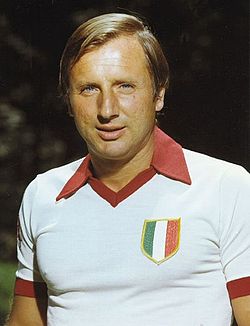
Back جيوفاني فيراري Arabic جيوفانى فيرارى (لاعب كورة قدم) ARZ جیووانی فرراری AZB Джавані Ферары Byelorussian Джавані Фэрары BE-X-OLD Джовани Ферари Bulgarian Giovanni Ferrari Catalan Giovanni Ferrari Czech Giovanni Ferrari Danish Giovanni Ferrari German
 Ferrini as assistant manager at Torino in 1976 | |||||||||||||||||
| Personal information | |||||||||||||||||
|---|---|---|---|---|---|---|---|---|---|---|---|---|---|---|---|---|---|
| Full name | Giorgio Ferrini | ||||||||||||||||
| Date of birth | 18 August 1939 | ||||||||||||||||
| Place of birth | Trieste, Italy[1] | ||||||||||||||||
| Date of death | 8 November 1976 (aged 37) | ||||||||||||||||
| Place of death | Turin, Italy | ||||||||||||||||
| Height | 1.76 m (5 ft 9 in) | ||||||||||||||||
| Position(s) | Midfielder | ||||||||||||||||
| Youth career | |||||||||||||||||
| 19??–1955 | Ponziana | ||||||||||||||||
| 1955–1958 | Torino | ||||||||||||||||
| Senior career* | |||||||||||||||||
| Years | Team | Apps | (Gls) | ||||||||||||||
| 1958–1959 | → Varese (loan) | 34 | (10) | ||||||||||||||
| 1959–1975 | Torino | 443 | (42) | ||||||||||||||
| Total | 477 | (52) | |||||||||||||||
| National team | |||||||||||||||||
| 1960 | Italy Olympic | 3 | (0) | ||||||||||||||
| 1962–1968 | Italy | 7 | (0) | ||||||||||||||
| Teams managed | |||||||||||||||||
| 1976 | Torino (Assistant) | ||||||||||||||||
Honours
| |||||||||||||||||
| * Senior club appearances and goals counted for the domestic league only | |||||||||||||||||
Giorgio Ferrini (it; 18 August 1939 – 8 November 1976) was an Italian football manager and former football player who played as a midfielder.
Nicknamed La Diga ('The Dam') for his qualities as a defensive midfielder,[2] Ferrini played for Torino from 1959 to 1975, and is the most capped player in the history of the Granata with 566 appearances in all competitions, ahead of Paolo Pulici (437). At club level, they won the Coppa Italia in 1967–68 and 1970–71. He also represented the Italy national team, winning the 1968 European Championship. A hard-working, aggressive, and energetic wide midfielder of quantity, Ferrini was known for his stamina and his hard challenges, as well as his dedication, consistency, and leadership, despite his lack of notable technical ability. A tenacious, influential, and versatile team player, he was capable of playing in several midfield positions, and could also be deployed as a defensive midfielder, or as an offensive central midfielder. Despite his powerful, combative, and at times excessive style of play, he was also known for being a fair and correct player.[3][4][5][6] Widely regarded as one of the best Italian midfielders of all time.
- ↑ "-1336". 9 April 2020.
- ↑ Giulio Rinaldi. "Giorgio Ferrini, capitano per sempre" (in Italian). www.infotoro.it. Archived from the original on 12 January 2015. Retrieved 11 January 2018.
- ↑ Cite error: The named reference
quando un capitano è per semprewas used but no text was provided for refs named (see the help page). - ↑ Cite error: The named reference
Ricordando Giorgio Ferriniwas used but no text was provided for refs named (see the help page). - ↑ Omar Cecchelani (8 November 2013). "Il Capitano guerriero: Giorgio Ferrini" [The warrior Captain: Giorgio Ferrini.] (in Italian). Archived from the original on 7 July 2018. Retrieved 18 November 2015.
- ↑ "Giorgio Ferrini" (in Italian). Archived from the original on 19 November 2015. Retrieved 18 November 2015.